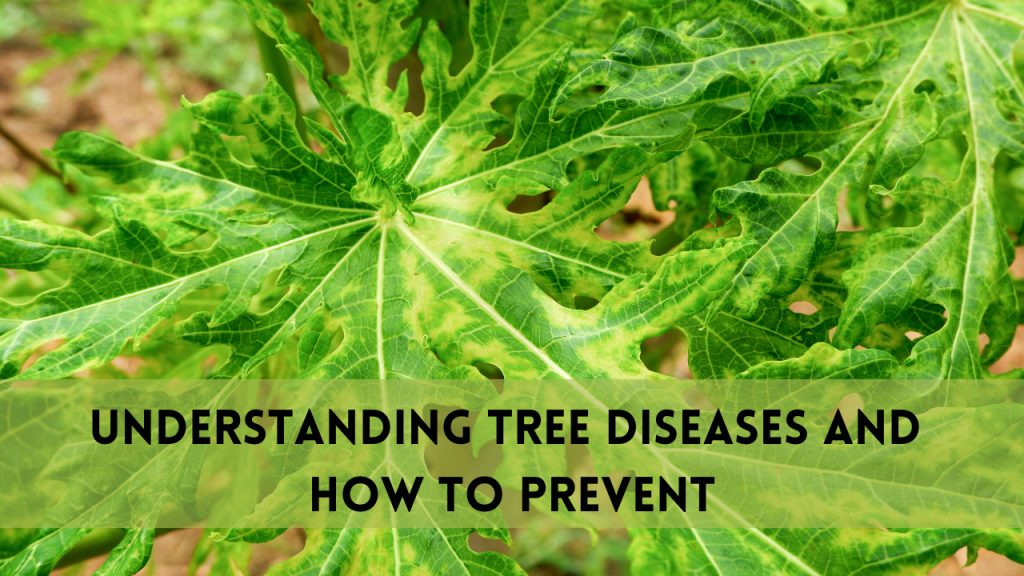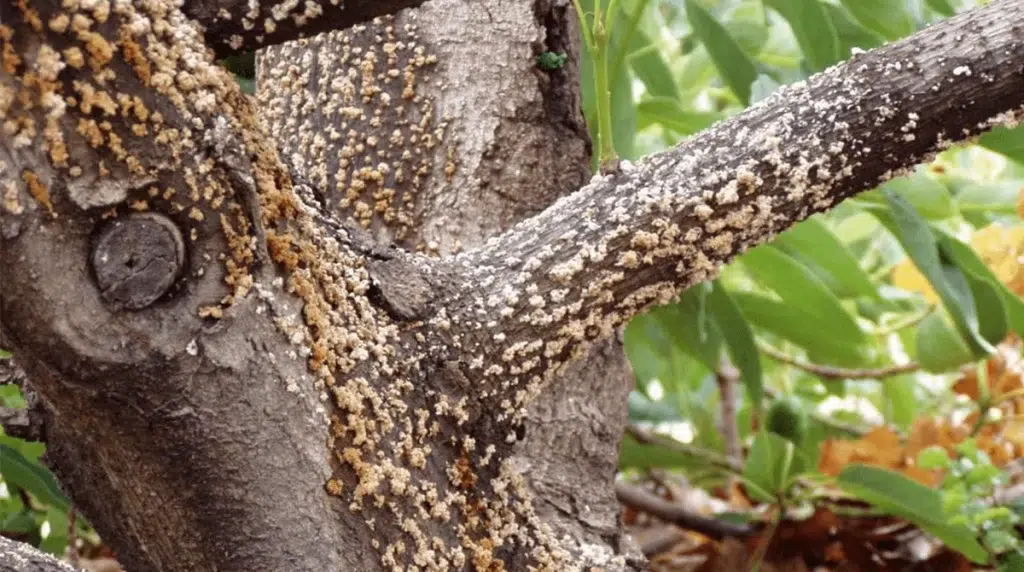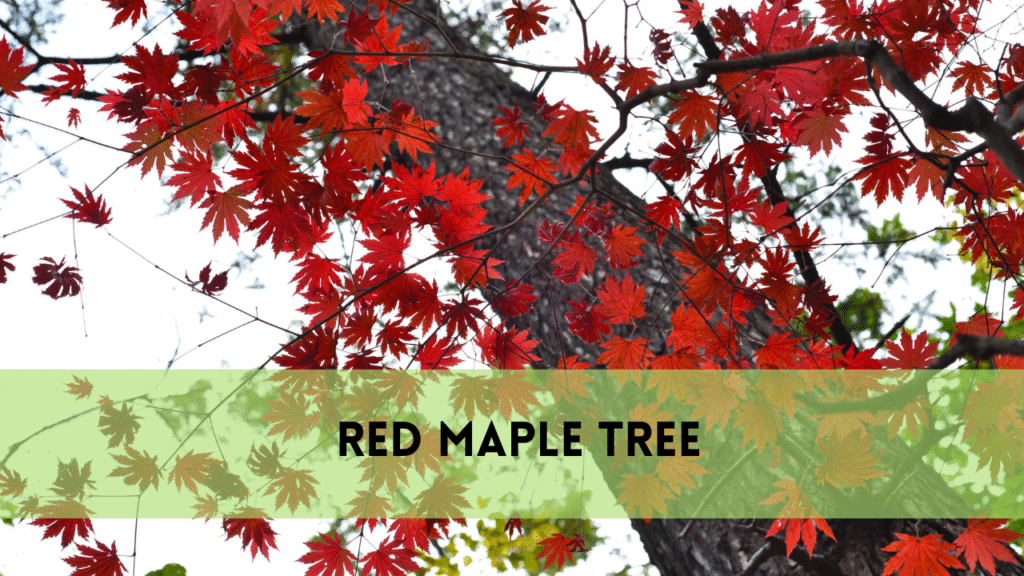If you’ve ever taken a stroll in a lush, green forest or marveled at the majestic majesty of a century-old oak in your backyard, you understand the joy and tranquility that trees offer to our lives. Trees are more than simply silent sentinels towering tall; they are vibrant, living organisms capable of suffering diseases just like any other living organism. Understanding tree diseases and how to prevent them is critical for anyone who values these majestic trees. Whether you’re an experienced arborist or a garden enthusiast, this guide will help you keep your trees healthy and thriving.
What are Tree Diseases?
Tree diseases are anomalies caused by pathogens such as fungi, bacteria, viruses, and nematodes. These diseases can affect any part of a tree, from the roots to the leaves, causing symptoms such as wilting, discoloration, defoliation, and even mortality if not treated effectively. Tree illnesses are divided into two categories: biotic (caused by living organisms) and abiotic (induced by non-living elements such as environmental stress, nutrient deficits, or physical damage).
Understanding Tree Diseases and How to Prevent Them
Common Tree Diseases
There are countless tree diseases, however, some of the more frequent ones you may encounter are:
Dutch Elm Disease: Elm bark beetles disseminate a fungus that causes this severe disease. It damages elm trees’ vascular systems, producing drooping and yellowing of the leaves and eventually killing the tree.
Oak Wilt is a fungal disease that infects oak trees, causing leaf discoloration, wilting, and defoliation. The fungus spreads by root grafts and beetles, and it can be lethal if not treated quickly.
Powdery Mildew: This fungal disease affects a wide variety of trees, covering the leaves with a white, powdery material. While rarely lethal, it can damage trees and impair their aesthetic value.
Anthracnose infects a variety of trees, including sycamores, oaks, and maples. It causes dark, deep lesions on leaves, stems, flowers, and fruits, resulting in defoliation and decreased vigor.
Fire Blight: This bacterial disease primarily affects fruit trees, such as apples and pears. It causes blooms to wilt and turn black, giving the appearance of being burnt by fire. The disease can spread swiftly, causing substantial damage.
Root Rot: Root rot is caused by a variety of fungi, which attack tree roots, resulting in degradation and death. It frequently develops in poorly drained soils where waterlogging is common.
Cedar Apple Rust: This fungus infects both cedar and apple trees. It causes orange, and gelatinous galls on cedars and yellow patches on apple leaves, resulting in defoliation and lower fruit quality.
Symptoms Of Tree Diseases
Recognising the symptoms of three diseases early on is critical for successful management. Some frequent symptoms to check for are:
Leaf Discolouration: Yellowing, browning, or reddening of leaves can suggest a number of illnesses.
Wilting leaves and branches, particularly under wet weather, are often indicative of vascular disease.
Fungal infection: Sunken, discoloured spots on the bark or stems may indicate fungal infection.
Defoliation: Many tree diseases are characterised by premature leaf drop.
Growths: Unusual growths, such as galls or mushrooms at the tree’s base, may suggest fungal infestation.
How to Prevent Tree Diseases.
Preventing tree diseases requires a mix of proper tree care, monitoring, and quick intervention at the first indication of trouble. Here are some detailed ways for keeping your trees healthy.
1. Select Disease Resistant Species
When planting new trees, choose species and cultivars recognised for their disease resilience. Some elm variants, for example, have been bred to be resistant to Dutch elm disease, while certain apple cultivars are less vulnerable to fire blight. Crosby Arborist’s experts can assist you in selecting the best trees for your area.
2. Proper Planting Techniques
Proper planting is critical for tree health. Ensure that the tree is planted at the appropriate depth, with the root flare (where the trunk spreads into the roots) slightly above the soil surface. Avoid planting too deeply or too shallowly, as this might stress the tree and make it more vulnerable to disease.
3. Use water wisely
Watering is essential, especially during dry spells, but over watering can lead to root rot. Water deeply but infrequently to promote deep root growth. Mulching around the tree’s base helps to retain moisture and maintain soil temperature, but avoid heaping mulch against the trunk, which can promote decay.
4. Prune properly
Pruning on a regular basis removes unhealthy or dead branches while also improving air circulation and lowering the risk of fungal diseases. Prune during the tree’s dormant season to reduce stress and prevent disease transmission. Clean your pruning equipment between cuts to avoid cross-contamination.
5. Maintain soil health
A healthy tree begins with a healthy soil. Ensure that your trees have well-drained soil with appropriate nutrients. Soil tests can help establish whether any amendments are required. Avoid compacting the soil near the tree’s root zone, which might limit root growth and water infiltration.
6. Monitor for pests and diseases
Inspect your trees on a regular basis for symptoms of pests and disease. Early detection enables timely treatment, which can keep small difficulties from becoming major problems. Familiarise yourself with the major pests and diseases in your area, and don’t be afraid to seek professional assistance if you’re unsure.
7. Practice good sanitation
To prevent the spread of diseases, unhealthy plant material should be removed and destroyed promptly. This contains fallen leaves, branches, and other detritus. For some diseases, like as fire blight, it is critical to disinfect pruning equipment after each cut.
8. Use fungicides and pesticides wisely
Chemical treatments should only be used as a last resort, but they can be useful in controlling some illnesses and pests. Always read the label and use the product that is right for your situation. Organic options, such as neem oil, can be effective while being less hazardous to beneficial insects and the environment.
9. Ensure proper tree spacing
Planting trees too close together can cause overcrowding, reduced air circulation, and increased humidity, all of which can promote disease transmission. To reduce these dangers, ensure that trees are spaced appropriately based on their mature sizes.
FAQS
How can I know if my tree is diseased?
Look for signs of leaf discoloration, wilting, lesions, cankers, defoliation, and abnormal growths. Regular inspections and early discovery are critical.
Can tree diseases spread to other plants?
Yes, many tree diseases can spread to other plants, particularly those in the same species. Infected plant material should be removed and disposed of as soon as possible to help avoid further spread.
Are all tree diseases fatal?
Not all tree diseases are lethal. Some can be controlled with careful care and therapy, while others may necessitate more drastic measures. Early intervention is critical.
Should I use chemical treatments against tree diseases?
Chemical treatments should only be used as a last option, and always in accordance with the label recommendations. Before using any pesticides, think about organic alternatives and visit an arborist.
How frequently should I monitor my trees for disease?
Regular checks are advised, particularly throughout the growing season. Inspect your trees once a month, or more frequently if you observe any symptoms.
Conclusion
Trees are an essential element of our ecosystem, offering shade, beauty, and a variety of ecological benefits. Understanding tree diseases and how to prevent them is vital for keeping trees healthy and bright. By selecting disease-resistant species, using proper planting and care practices, and keeping an eye out for symptoms of difficulty, you may help ensure that your trees thrive for future generations. If you need expert advice or assistance with tree maintenance, do not hesitate to contact Crosby Arborist.





